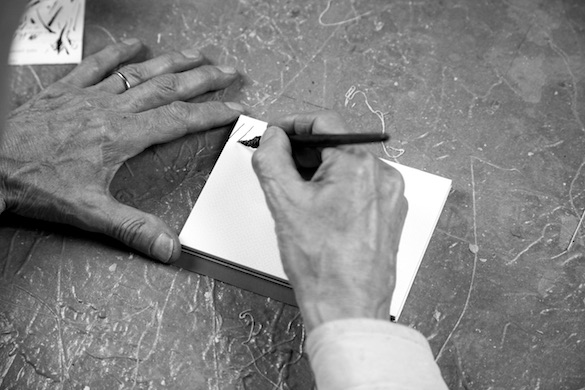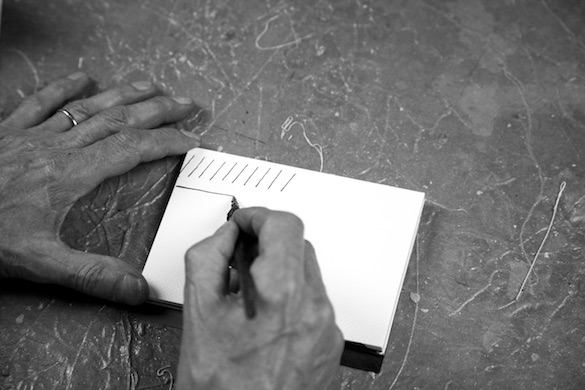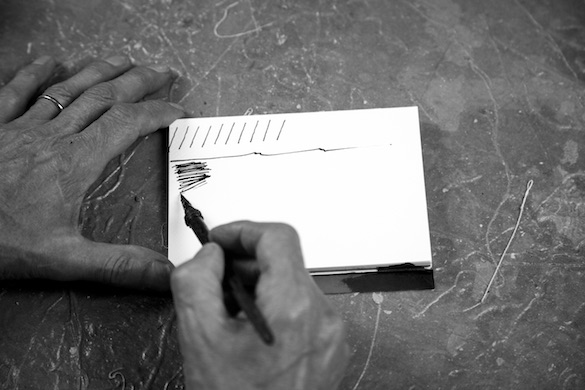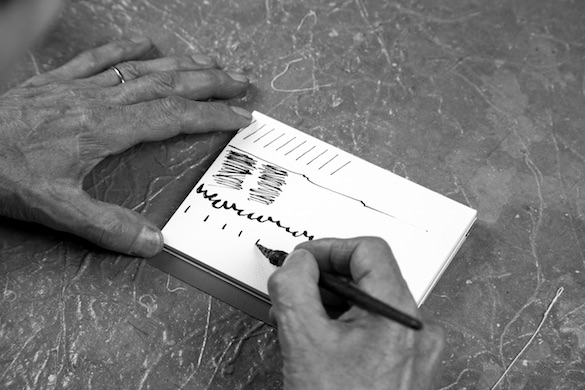Giorgio Griffa
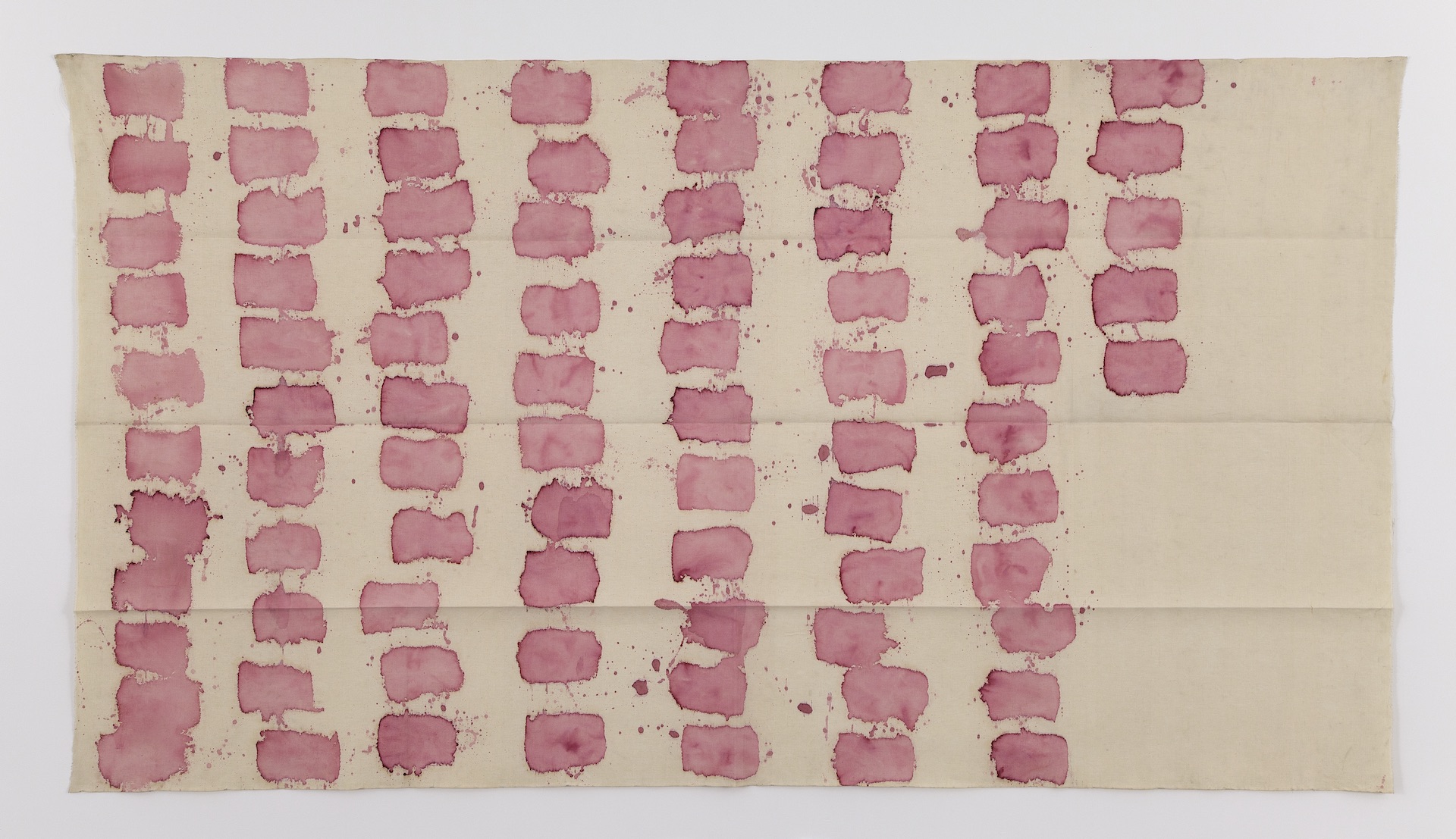
Et in macula ego
A smudge. Right beside the motif. A motif with vague outlines, what is more. Not one but many different smudges, in fact. Tiny ones, some almost microscopic, droplets of paint spangling the untreated jute like stars. Further on, we find thick cotton tinged with marks between the brush strokes. Elsewhere the linen has so effectively absorbed the colour of the liquefied acrylic that the motif seems to be dissolved in its weft.
The manner does not allow any pentimento. The matter lets itself be penetrated. Or rather the different matters penetrate each other. From now on there is no longer any clear superiority of the paint over the canvas on which it is applied, because the two merge. The paint becomes a dye. It blends with the fibre that informs it. In one and the same movement, the colour reveals the supple geometry of the weave, acknowledging the one or two imperfections of its orthonormal layout. A contamination is at work, which is as literal as it is metaphorical.
At first glance, it is hard to distinguish what is planned from what is accidental. What is intentional from what is providential. “Griffa works with materials rather than using them”,1 writes Francesco Manacorda in a moving essay where he describes his first contact with a contemporary work of art which turns out to be a piece by the said Griffa.
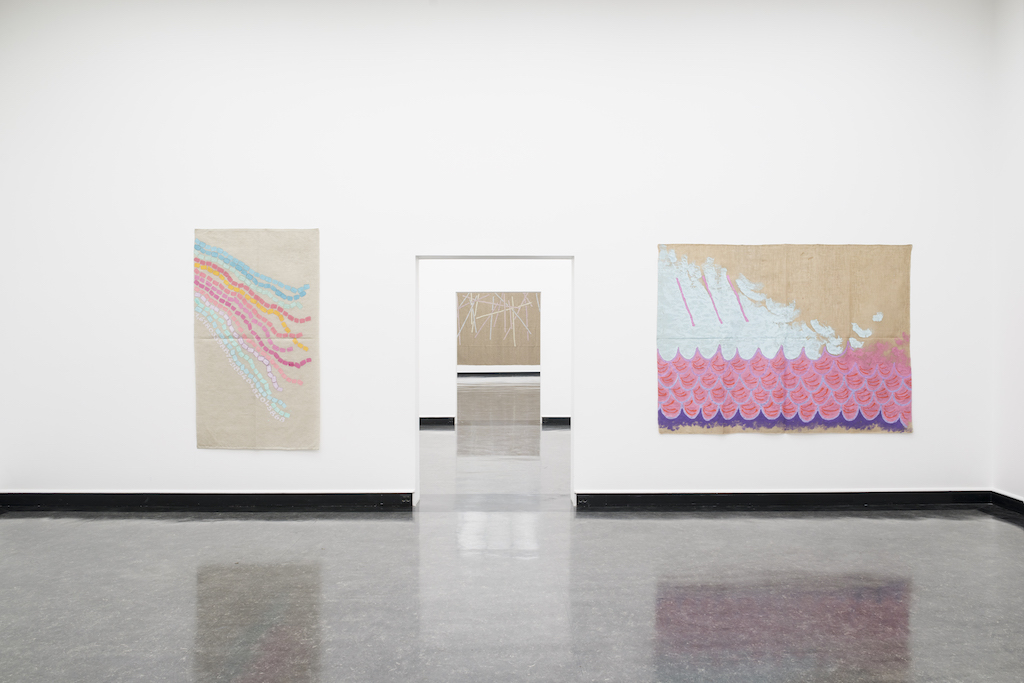
View of the exhibition Giorgio Griffa: Painting into the Fold, Bergen Kunsthall, 2015. With, on the left: Canone Aureo 868, 2014. Acrylic on canvas, 204 x 120 cm. On the right: Viola sotto, 1989. Acrylic on canvas, 180 x 240 cm. In the background: PAOLO E PIERO, 1982. Acrylic on canvas, 300 x 540 cm. Photo: Thor Brødreskift. Courtesy Giorgio Griffa ; Casey Kaplan, New York.
Between 1968 and 1971, the young Giorgio Griffa laid the foundations which he would never stop developing throughout his career—and is still developing. A canvas spread on the floor, paint diluted to the point of becoming liquid, a succession of simple signs, one material that soaks up, another that is soaked up.
In a text written in 20002, in which he discussed his closeness to the artists who would form the Arte Povera movement, and famously declared that “the intelligence of matter […] became the protagonist of the work, and the artist’s hand was there to serve it”, the Turin-based artist described Giuseppe Penone’s famous Alpi Marittime (1968) as “a tree imprisoned by a hand of iron [which] modifies its own growth until it incorporates the object, which is no longer foreign to it”. Incorporate the object, which is no longer foreign to it. The canvas thus appropriates the paint, thus getting rid of its function as a medium. And the intelligence of these matters gets to work.
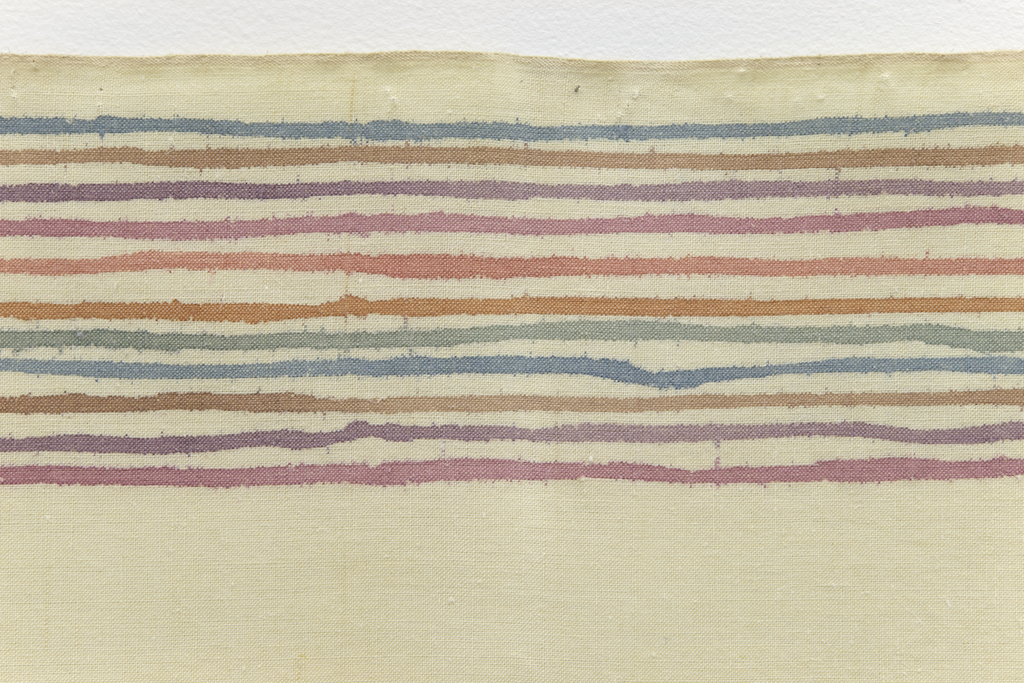
Giorgio Griffa, Linee orizzontali, 1973 (detail). Acrylic on canvas, 150×435 cm. Photo : Jean Vong. Courtesy Giorgio Griffa; Casey Kaplan, New York.
And what about the artist’s hand? It compels itself to adopt simple gestures made by man from time immemorial: straight and curved lines, long and short, and imprints… Each sign brings on the following one—the first one is, as it were, “gratuitous”, and the others result from it. Their consecutiveness is presided over by a very slow task, one which calls for deep concentration. A hand which controls itself in order to master the liquid colour, a hand which refrains from passionate movements, in a state of attentive and rational passiveness. These last words are those of the artist, who is fond of explaining that, unlike an artist such as Pollock, his gesture is “neither mystical, nor erotic, nor romantic”. That he does not impose anything—or very little. That all he has in mind is the first of the signs he will draw when he starts to paint, and then that he tries to follow the process which takes place on the canvas. “There was no project, just that first sign, and all the rest happened in the work”, to use his own words again. All the rest happened, the way we say of an event that it happened.
The sign, here, is the event. Andrea Bellini— curator of a series of four shows devoted to Griffa between May 2015 and September 20164—very aptly points out as much in an essay dealing with the Turin-based artist’s work on paper: “The aim in both painting and drawing is to observe the event-sign in its making, instead of using the sign to tell of an ‘event’ that is outside of the work”.5 If the sign is what happens, what originates and what results, then it is a fact. At once an act and the result of that act, it is what one observes. Like the world, like all the other facts, to paraphrase the opening of a famous philosophical treatise (The world is all that is the case. The world is the totality of facts, not of things. The world is determined by the facts. […] The world divides into facts).6 Paintings and drawings are part and parcel of the world, and not its commentary. “We are part of the phenomenon we observe”.7
The sign here is the expression of a rhythm. Very simple, and timeless (it is the rhythm of the heart, of the breath, of ancestral percussions), but flexible, it displays no rigour.
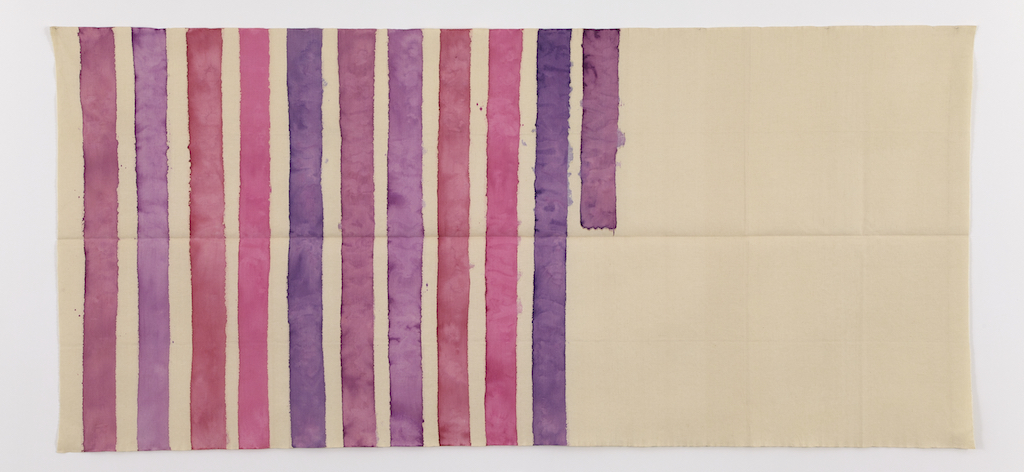
Giorgio Griffa, Viola verticale, 1978. Acrylic on canvas, 150×321 cm. Photo : Jean Vong. Courtesy Giorgio Griffa; Casey Kaplan, New York.
A sort of calendar-like punctuation (it conjures up the prisoner and the lines he draws for counting the days). Like an accounting of nothingness, futile, a feigned regularity. (Dis-)counting without counting, what is there to count? There is more to scan,“it was the scansion of my measure whose memory came back to me prolonged both by the sound in the temporal corridor of the door to my sepulchre, and by hallucination.” 8
Here the passage of time is indefinite because time itself is indefinite. No date stamps as with Parmentier, no identical repetition of a motif as with Toroni, nor any repetition of an evolving motif as with Kawara and Opalka, no fine measurement of data as with Darboven; an unmeasured regularity, a non-metronomic rhythm is at work. Time includes and suspends itself, all at once. Giorgio Griffa says he prefers “to underline the rhythm rather than the repetition of the sign”, because “rhythm has always been a means of knowledge (rhythm of agriculture, rhythm of the moon…)”. So he is not trying to enclose time in the canvas, but, almost to the contrary, he is placing his canvas in time.
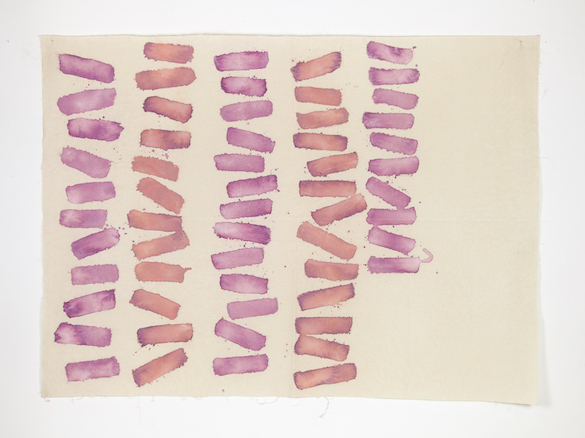
Giorgio Griffa, Verticale orizzontale, 1978. Acrylic on canvas, 115 × 157 cm. Photo : Giulio Caresio. Courtesy Giorgio Griffa.
This is a writing without language, which refers to nothing external, and yet talks about the world. There are punctuation marks, commas, apostrophes, dots which are not “full stops”. Dots which evoke the start or the continuity of something, but certainly not its end. A language which produces no tale, which remains opaque, impervious to any narrative. For Griffa there is indeed a story, “but the story being told is that of this event of the sign, it is not a story outside it. It may also be that the story is different for everyone, just as it is different for each person listening to music, or for each reader of the Greek myths…” For him who readily quotes Whitman, Eliot, Joyce, Dante, Villon and Rabelais, Pound’s Cantos and Ginsberg’s Kaddish are corner stones.
Le Paradis n’est pas artificiel
but spezzato apparently
it exists only in fragments9.
The fragment fascinates Griffa. What is more, one of his cycles of works bears its name, yet, even though its writing—this time around of letters and words—is also incarnated in usually fragmentary forms, it cannot be said that his painting is fragmentary. Needless to say, his canvases lay claim to the fact of being a part of a whole, but they do not have the essential tearing of the fragment, the brevity necessary for this break. Despite their flagrant unfinishedness—“the knowledge of that deep unknown that science can never fathom is assigned to the realm of poetry”10, writes the painter—they do not seem to be unfinished, they simply curtail the confinement of the allover in itself. Griffa’s painting is a painting whose interest does not originate in a self-centred line of thinking, but comes, conversely, from altogether external questionings re-used in this medium, after being used by others, in others. The Turin-based artist has not incidentally chosen painting over and versus other kinds of creation. He has chosen it because he reckoned that was “all he was good for”, a bit like Beckett.11
The non finito, the unbound, unframed canvas, which frays on the wall, the infinite number which cavorts about in it, all give the eye a chance to continue the painting itself. “I don’t have the time to finish my works. I cannot apply the paint up to edge of the canvas because in the meantime life has passed by. Furthermore, the painting is only a trace of an action and it would be arbitrary to attribute it a completeness it cannot have.”12 “For him, rather than having a canvas which becomes a frame or that disappears, it’s about the object”, observes Martin Clark, joint curator of the exhibition “Giorgio Griffa: Painting into the Fold”, with Andrea Bellini, “the object quality of the painting enhances the truth of the material”.
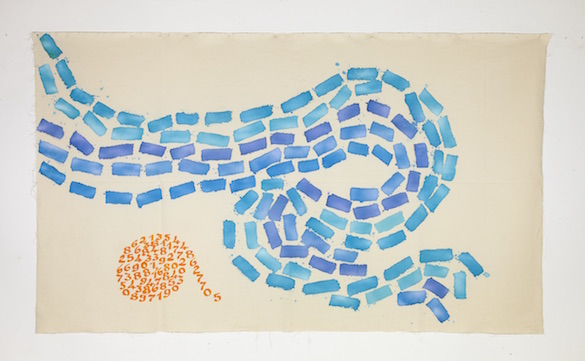
Giorgio Griffa, Canone Aureo 705, 2015. Acrylic on canvas, 140 × 237 cm. Photo : Giulio Caresio. Courtesy Giorgio Griffa.
The only signs to emerge from this paint-canvas merger, which relate directly to an objective reality, are the numbers. Numbers which, first of all, appeared in the cycle of the Tre linee con arabesco,13 in order of number the works. Numbers which, then, in the Numerazioni, sort of underlined the signs, the sets of signs, and rendered literal their arrival on the canvas, showing that the temporal order of the layout of the signs did not necessarily take into account any spatial organization. In 1993, the Canone aureo, the golden number, lent its name to a new cycle, in which the painter found an object responding to his greatest preoccupations: the sharing, over and above any time-frame, of an object deeply rooted in time—in effect the number was formalized by Euclid more than 2,300 years ago, but its applications go back much further, and, at the same time, it is presented as infinite—but also of an abstract object which offers, in itself, a clue to its possible visible interpretation—as decimals are added to it, these decimals become smaller, producing a kind of numeral vortex. “This number does not progress. It spirals into the unknown”,14 Griffa incidentally writes about it. And in his painting, it spirals over the canvases. It undulates, it whirls, it follows the motifs or subsequently creates new ones. “The number is a sign, an image used at the service of something other than itself, […][but] I could not use numbers outside their function. They would have become unacceptable decorative tinsel in my work.”15 If he denies producing anything akin to decorative aestheticism,16 the recourse to the golden number nevertheless incorporates his painting more overtly in the trans-temporal continuity that he is seeking, in a more direct and almost evident way, thus touching upon the question of illustration, while his painting draws close to a universal writing, exceeding the power of poetry insomuch as it is precisely not linguistic.
Myself, anyhow, maybe as old as the universe
and I guess that dies with us
enough to cancel all that comes
What came is gone forever every time
That’s good! That leaves it open for no regret
[…]
Is it only the sun that shines once for the mind,
only the flash of existence, than none ever was?17
It simultaneously shades off and sketches out. No stroke is assured, no line is straight; it wavers and it sways; the paper itself is sometimes torn at the edge, and as for the canvas, it brushes against the wall. Gently, letting the slightest breath of air move it a little.
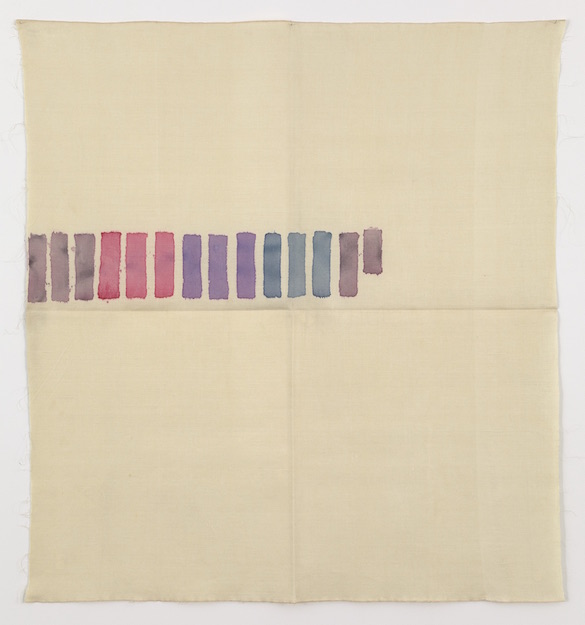
Giorgio Griffa, Pennello Piatto, 1971. Acrylic on canvas, 150 × 135 cm. Photo : Jean Vong. Courtesy Giorgio Griffa ; Casey Kaplan, New York.
Drawing and painting alike are the arena of a struggle being perpetually re-enacted: the softness and the joyousness of the colours, the vigour and the beauty of the motifs floating in their cosy little world against their insinuation in the real world, their infiltration of the woven fibres and those of the paper. The haphazard smudges take on the role of incarnating the signs they rub shoulders with, fastening them to the support, and to life.
Never the same canvas, never the same paper, more or less never the same formats lend this scene material form. How is the feeling of a repetition to be given without ever repeating yourself? “Because nothing is ever equal, because everything changes, because contamination and variation are continual, each sign is different from the others. These signs are a bit like the reflection of people who all have a mouth, a nose, and eyes, and yet are all different.”
This regularity which is not systematic has something poignant about it; in it we see man struggling with his finiteness, his incompleteness, the world which precedes him and succeeds him, his humanity in the face of stable, physical, mathematical and dogmatic theories.
Man is unstable, impermanent and fragile, with a desire to inscribe, to leave a mark behind him, but this mark is also (here) impermanent. The consciousness of this impermanence; the fragile stubbornness of these paintings with their trembling layouts, done freehand—“the hand is weak, it is not a machine, it is always making mistakes”—traversed, infused, and inspired by more or less readable references, Chinese and Arabic calligraphy, Aboriginal painting, poetry, literature—there is in the curled up corners at the bottom of the canvases something of the dog-eared pages of a much-loved book—music, other works by other artists—18 “Matisse was seeking purity, I’m seeking contamination. Everything in life, in knowledge, comes from contamination” —; this interplay of intention and chance which does not clearly submit itself to evolution but rather to variations—the cycles exist together all at once, never complete, endlessly open—goes to make Giorgio Griffa’s œuvre. It is all Giorgio Griffa’s œuvre.
“Reason always loses to chance, to the unknown”, to conclude with his own words.
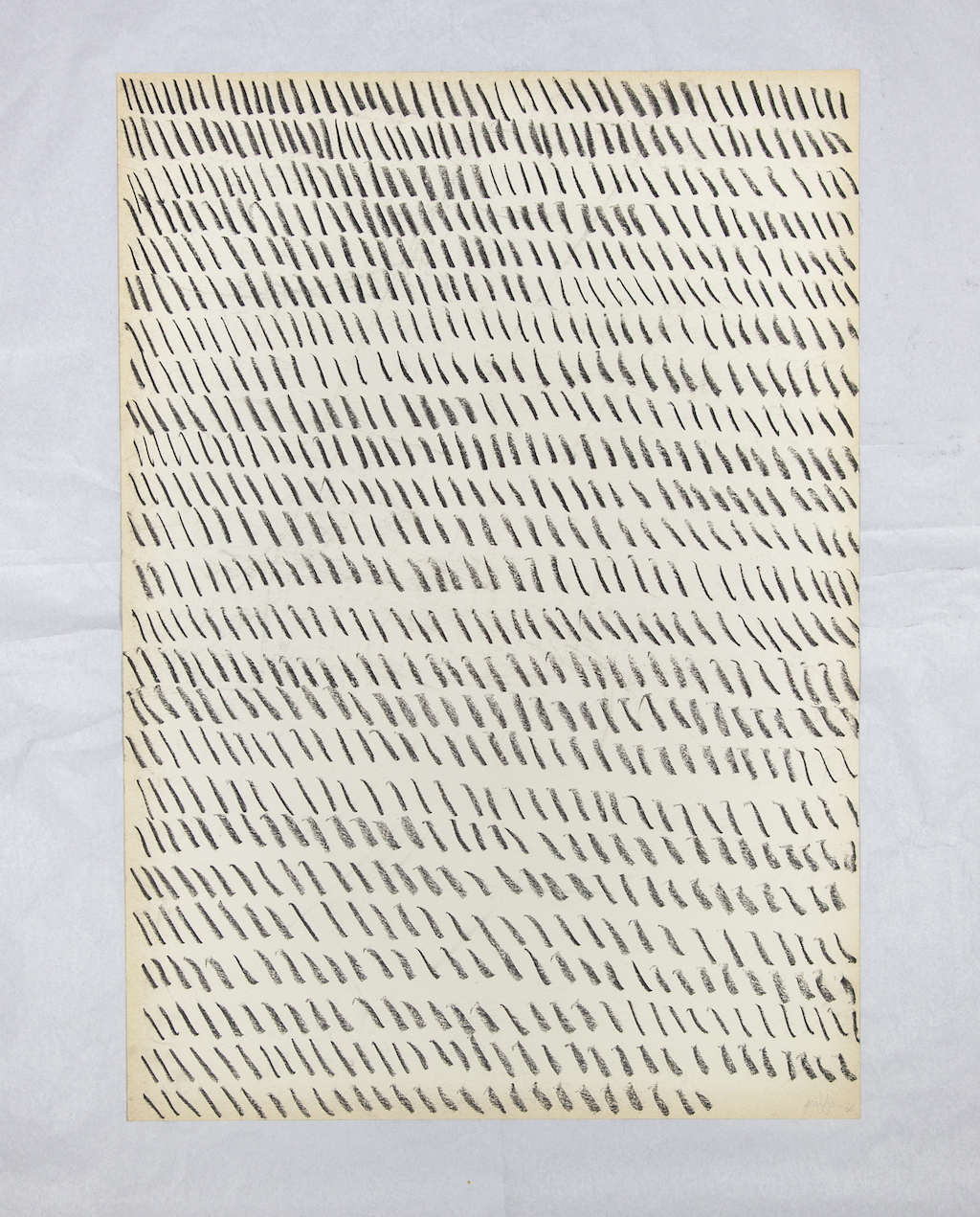
Giorgio Griffa, (Pastel on paper), 1968. 67,5 × 48 cm. Photo: Giulio Caresio. Courtesy Giorgio Griffa.
1 Francesco Manacorda, “Giorgio Griffa: The Uninterrupted Sequence of Interruptions”, in Giorgio Griffa, Fondation Vincent Van Gogh, Arles / analogues, 2016, p. 46.
2 Giorgio Griffa, “Intelligenza della materia”, 2000, published in I flaneur del paleolitico, Maretti Editore, 2014, p. 50-53, quoted by Laura Cherubini in “Indeterminate Representation”, Giorgio Griffa, Works: 1965-2015, 2015, Centre d’Art Contemporain, Geneva ; Bergen Kunsthall ; Fondazione Giuliani per l’arte contemporanea, Rome ; Museu de Arte Conteporanea de Serralves, Porto / Mousse Publishing, p. 37-38.
3 Excerpt from an interview with the artist in Rome, 5 February 2016. All the other quotations which do not refer to notes come from conversations with the artist.
4 “Giorgio Griffa : Une rétrospective, 1968-2014”, Centre d’Art Contemporain, Genève, 29.05_16.08 2015, curated by: Andrea Bellini ; “Giorgio Griffa: Painting into the Fold”, Bergen Kunsthall, 28.08_18.10 2015, curated by: Andrea Bellini and Martin Clark ; “Giorgio Griffa: Works on Paper”, Fondazione Giuliani, Rome, 5.02_9.04 2016, curated by: Andrea Bellini, and “Giorgio Griffa: Quasi Tutto”, Museu de Arte Conteporanea de Serralves, Porto, 21.05_4.09 2016, curated by: Andrea Bellini and Suzanne Cotter.
5 Andrea Bellini, “Transcending Painting: Giorgio Griffa’s Works on Paper”, in Giorgio Griffa Works on Paper, 2016, Fondazione Giuliani per l’arte contemporanea, Rome / Mousse Publishing, p.16.
6 Ludwig Wittgenstein, Tractatus logico-philosophicus, (1921), 1., 1.1, 1.11, 1.2. Translated from the German by Frank P. Ramsey and C.K. Ogden.
7 Giorgio Griffa, “The Divine Proportion”, in Giorgio Griffa, Fondation Vincent Van Gogh, op. cit., p. 32: “Heisenberg’s uncertainty principle belongs to our modern age. According to this, it is impossible to know the location or speed of a particle moving in space, since the energy we expend in examining one of the aspects influences the other and makes the whole thing indeterminable. This means […] that we are part of the phenomenon we observe : we look at the world from a window, but we are also inside it, and so our observation is modified.”
8 Stéphane Mallarmé, Igitur, 1869. Translated by Mary Ann Caws.
9 Ezra Pound, Cantos, 1954.
10 Giorgio Griffa, “The Divine Proportion” in Giorgio Griffa, Fondation Vincent Van Gogh, op. cit., p. 32.
11 Samuel Beckett’s reply—“That’s all I’m good for” —to the question asked in the special issue of Libération: “Why do you write? / Pourquoi écrivez-vous ?” published in 1985. It is nevertheless important to know that we are talking here in the strict sense of the choice of a medium, Giorgio Griffa having worked as a lawyer for some thirty years in tandem with his activity as a painter.
12 Giorgio Griffa, Kunstraüm Munchen, 1975, reproduced in Giorgio Griffa, Works: 1965-2015, op. cit., p. 200.
13 Cycle embarked upon in 1991.
14 Giorgio Griffa, “The Divine Proportion”, in Giorgio Griffa, Fondation Vincent Van Gogh, op. cit., p. 32.
15 Ibid. p 34.
16 “These notes are for those who think my painting is a more or less elegant exercise in decorative aestheticism. I would like to tell them that I believe and trust in the lyrical value of color and signs, but I do not think of painting, and art in general, as an escape from reality, a free zone. Just the opposite: I believe art continues to be a tool of awareness and therefore an immersion in reality”, in Giorgio Griffa, Post Scriptum, 2005, Turin, Hopefulmonster Editore, p.7.
17 Allen Ginsberg, Kaddish.
18 Alter Ego is a cycle of “homage” paintings started in 1978. The first is a triptych which conjures up the work of Matisse, Klee and Klein. Others suggest influences of Uccello, Tintoretto, Beuys, Buren, Marden, Delaunay, Merz, Anselmo…
“Giorgio Griffa: Works on Paper”, Fondazione Giuliani, Rome, 5.02_9.04 2016, curated by Andrea Bellini
“Giorgio Griffa”, Fondation Vincent Van Gogh, Arles, 13.02_24.04 2016, curated by Bice Curiger
“Giorgio Griffa: Quasi Tutto”, Museu de Arte Conteporanea de Serralves, Porto, 21.05_4.09 2016, curated by Andrea Bellini and Suzanne Cotter
- From the issue: 77
- Share: ,
- By the same author: Kate Crawford | Trevor Paglen, Thomas Bellinck, Christopher Kulendran Thomas, Hedwig Houben, Pamela Rosenkranz,
Related articles
Iván Argote
by Patrice Joly
Laurent Proux
by Guillaume Lasserre
Diego Bianchi
by Vanessa Morisset
